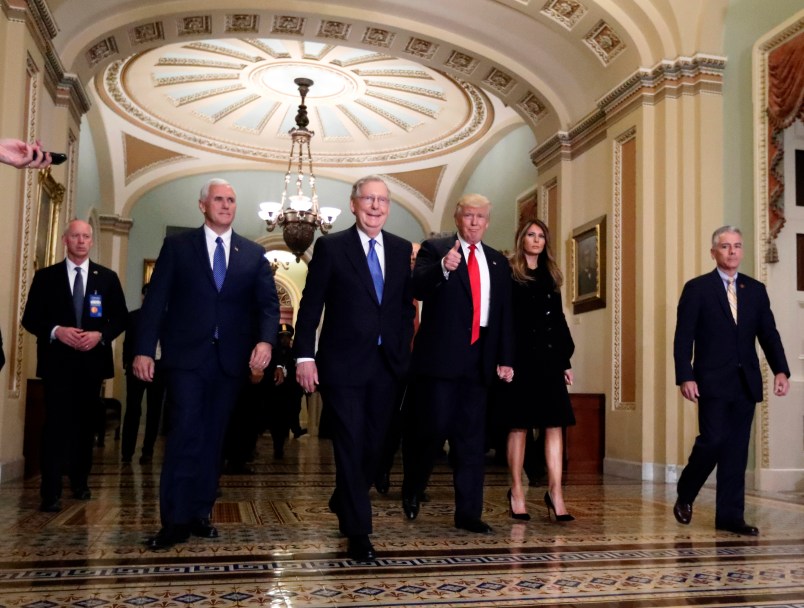When Senate Majority Leader Mitch McConnell (R-KY), within a few hours of Justice Antonin Scalia’s unexpected death in February, declared that his seat should remain open for the next president to fill, no matter whom President Obama nominated, many were quick to cry foul.
Democrats argued that the GOP, yet again, was proving to be the party of obstructionism, and the voters would punish Republicans for the unprecedented gambit. Legal observers, including some conservatives, fretted over the constitutional norms that were being shattered with the move, along with its political wisdom. Some Republicans even signaled their discomfort with the stance, particularly after Obama nominated a 63-year-old moderate who, they argued, would be better for them than whatever young liberal a President Clinton could be expected to nominate.
And then Tuesday’s shocking Donald Trump victory happened, and McConnell’s gamble paid off in spades.
Say what you want for what it means for Supreme Court politics going forward. On a purely tactical level, McConnell’s move was a smashing success. The Supreme Court will almost immediately be restored to the conservative-leaning status quo it had before Scalia’s death. Trump himself may have benefitted from the GOP’s blockade, giving conservative voters skeptical of his commitment to their movement an issue to mobilize around.
Rewind to February and it’s perhaps easy to forget how brazen McConnell’s gambit was. Scalia’s death was a shock to say the least and one that took place at an inopportune time — becoming public on a Saturday afternoon during a holiday weekend — for Republicans to figure out how they were going to act. With Congress in recess, GOP lawmakers were in their home districts, while the party’s candidates for president were about to take the stage for a primary debate. McConnell, by early evening, had issued a statement asserting that “this vacancy should not be filled until we have a new President,” which was quickly interpreted as a sign that the GOP would stand in Obama’s way if he tried.
“That shows the wisdom in the stance he took,” Carrie Severino, chief counsel and policy director of the conservative legal organization Judicial Crisis Network, told TPM. “It had to be a very clear principled line and send a message that everyone was reading off the same page. That was the reason we were able to maintain the consistency.”
Her group would ultimately spend upwards of $7 million, she said, supporting Republicans on the airwaves for taking the stance.
Democrats, caught off guard by the move, were angry and frustrated. But they almost immediately spun that they could use it to their advantage. Voters wouldn’t approve of Republicans’ disrupting one of the President’s most important duties, they said, and this would be a liability for the vulnerable GOP incumbents up for re-election.
The risk of the gamble became especially apparent during the general election as conventional wisdom settled that Trump was headed towards defeat, and some Republicans began to grumble that maybe they’d want to be pushing Obama’s nominee, Judge Merrick Garland, in a lame duck session after all.
“They were going to be basically between a rock and hard place, at some point,” Timothy Johnson, a political science professor at the University of Minnesota, told TPM. “They were going to have to accept someone who [Clinton] put up, and the court would have fundamentally changed for the next 30-40 years.”
Trump’s victory meant a GOP debate over considering Garland would no longer be necessary.
According to Eric Lomazoff, a political science professor at Villanova University, part of Democrats’ problem may have been that they did not have a “hot button issue that’s currently before the court or seems to be headed to the court” that they could have presented to the electorate.
Clinton would talk about appointing justices who would protect Roe v. Wade and would be skeptical of Citizen’s United, but it wasn’t a central part of her campaign. Where a left-leaning Supreme Court could really benefit Democrats isn’t always easy to put on a bumper sticker.
“How do you activate the electorate on the claim that we need this fifth vote, and we need it because we want to get rid of these ridiculous partisan gerrymanders that basically operate with racial effects?” Lomazoff said.
Trump, meanwhile, made filling Scalia’s seat a mainstay of his stump speech, often riling supporters up over the 2nd Amendment, a major issue among the base. To quell Republicans troubled by his apparent lack of knowledge or interest in conservative legal thought, he also released a list of judges from where he vowed to chose his Supreme Court appointees.
“The list was absolutely key to the success of Trump’s campaign,” Severino said. “People realize he is not a lawyer, he is not someone like Ted Cruz where he could talk about his philosophy personally. But it showed that he was really committed to this issue.”
There’s reason to believe it helped ease his path to victory. Exit polling suggests that one-in-five voters considered the Supreme Court the most important factor in their decision, and those voters broke — 57 percent to 40 percent — for Trump.
The payoff is huge for Republicans. Before Tuesday, liberals were already salivating at what a shift to the left would mean for the Supreme Court. Now they’ll be back to playing defense and begging for Kennedy’s occasional swing vote, while praying that the court’s older liberals, Justice Stephen Breyer and Justice Ruth Bader Ginsburg, can hang on for at least a few more years. The Scalia-like judge whom Trump has promised to nominate will likely sit on the court for decades.
“At this point, whomever President Trump picks is going to pretty much sail through the Senate, and while the Democrats do have some strategies they can use to block it, they’re probably not going to be successful,” Johnson said.
But some legal scholars warned of the longterm consequences of McConnell’s power grab.
“Now you have ratcheted up the stakes in Supreme Court confirmation politics in a way where, what isn’t fair game anymore?” said Charles Gardner Geyh, the author of “Courting Peril: The Political Transformation of the American Judiciary.” He pointed to the conservatives who, in anticipation of a Clinton win, argued that all of her nominees should be blocked throughout the entirety of her term
At the very least, it can be expected that if the tables are turned, and a GOP president has a vacancy to fill in his final year while the opposing party holds the Senate, Democrats will be using McConnell’s words against Republicans.
“In an era of divided government, a president’s window for nominating justices to the court could be as little as three years,” Lomazoff said. “And that doesn’t seem to square with the structure of the Constitution and the Constitution-responsibility of the Senate, but that’s clearly the informal rule that has been imposed. You can call it the McConnell rule perhaps.”










